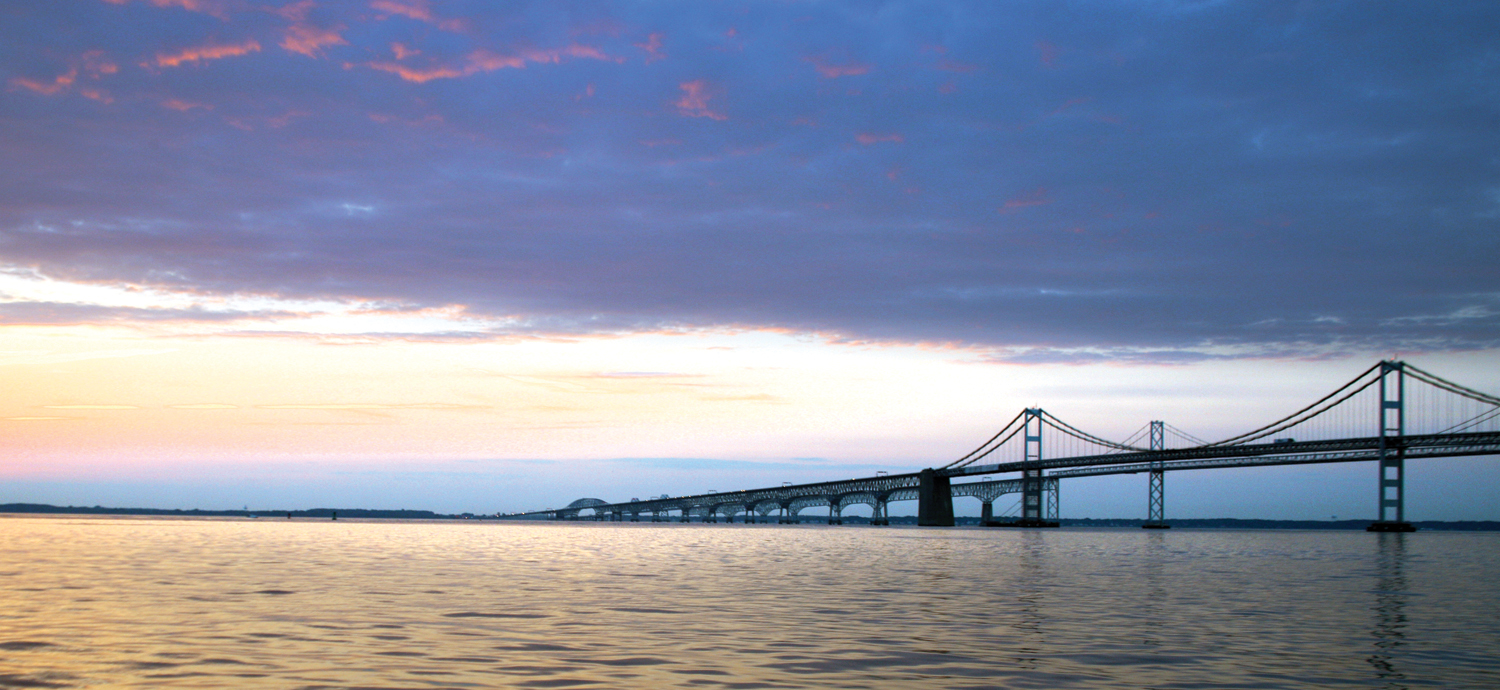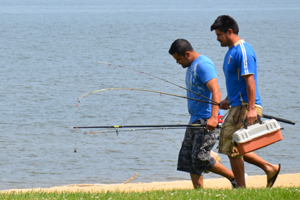Sandy Point State Park: The fastest-growing town in Maryland

Sunrise at Sandy Point; by James Phelps
The sky is just beginning to wake up when the line begins forming.
In the time it takes the horizon to go from inky black to soft blues and pinks, cars multiply and snake from the entrance of Sandy Point back toward the U.S. Route 50 exit ramp.
Everyone, it seems, wants to be a citizen of the state’s fastest–growing town, a community that goes from zero to 10,000 residents each summertime Saturday and Sunday in a matter of hours.
Sandy Point isn’t the state’s oldest park. That honor goes to Patapsco Valley. It isn’t the largest. That title belongs to Gunpowder Falls. The popularity of Sandy Point is measured instead by attendance. Last year, it exceeded one million visitors, the only state park besides Assateague ever to hit that mark.
It used to be that Sandy Point reached capacity only on the three holiday weekends: Memorial Day, Independence Day and Labor Day. But last year, it filled every, single weekend.

A popular swimming spot; by Anthony Burrows
What’s the attraction?
“It’s the gateway to all the Chesapeake Bay has to offer, the last stop before you get to the Eastern Shore,” park manager Steve McCoy explains.
If Sandy Point were a real town, McCoy would be its mayor, with all the challenges and rewards that come with the territory.
“We have the same issues as a city: public safety, crowd control, traffic and parking issues,” McCoy says.
Sandy Point has the state’s busiest public marina and boat ramps. It has 10 miles of natural sidewalks that lead to marshes and woodlands. It has a small store. And it has a law enforcement agency in the form of the Natural Resources Police.
The “chief,” Acting Lt. Aaron Parker, is a 20-year veteran of the department and has been at Sandy Point since 2003. The growth of the park in that time “has been amazing,” he says.

A busy day on the beach; by Nita Settina
Keeping order
Parker guides a small contingent of officers who patrol not only the park and marina, but also the Chesapeake Bay and its tributaries from northern Anne Arundel County to Breezy Point in Calvert County.
For four of his officers, 2016 is their first summer at Sandy Point.
“It’s definitely a small town, people everywhere,” says Parker, leaning back in his chair. “We can tell new officers. We can show them pictures. But it’s not the same. They have to experience it. I’ve had officers overwhelmed.”
Parker and McCoy meet frequently to stay on top of the challenges. One of the biggest is getting people safely inside the 786-acre tract.
When the park reaches capacity—dictated by the 1,500 parking spaces—managers shut the gate and put out the word on social media, the park web page and on electronic message boards beyond the park’s boundaries. Managers don’t wave new park-goers in until 150 to 200 parking spaces open up. On a busy summer weekend, that can take up to four hours.
“We’re all about customer service. We don’t want to close more than once a day and disappoint people, so we don’t rush to reopen,” McCoy says.
Parker and McCoy work with other agencies, such as the State Highway Administration, the Maryland Transportation Authority and State Police, to keep waiting traffic from clogging U.S. 50 or filling nearby neighborhood streets.
“Still, you might get a guy pull out a portable grill and make some food while he’s waiting,” Parker says, laughing. “We try and discourage that.”

Anglers looking to enjoy a day of fishing; department photo
Park Roots
The park officially opened on June 25, 1952 at the site of a pier for the Chesapeake Bay Ferry System. But the area—with few amenities—was in use two years earlier, documents show.
With little development in 1950, the attendance was already an estimated 75,000 persons, the state planning commission reported to then-Governor Theodore McKeldin and the General Assembly. The Master Plan for State Parks urged spending $1.7 million for swimming pools and 30,000 lockers, two cafeterias, parking lots and roads.
Even without the fancy extras, families found plenty to like: sandy beaches and bathhouses, and areas to crab and fish. And early park goers could marvel at the newly constructed two-lane Bay Bridge, which opened in July 1952 and made the ferry obsolete.
However, as with many public accommodations of its time, Sandy Point welcomed only white patrons despite a regional African American population of about 64 percent.
In 1955, the barrier was removed at Sandy Point, Fort Smallwood Municipal Park Beach and Baltimore City swimming pools by a U.S. Supreme Court decision.
By July 1978, Sandy Point was attracting 126,000 visitors annually.

A seagull amongst the crowd; by Nita Settina
Sandy Point in the 21st Century
Ironically, the very diversity lacking in Sandy Point’s beginnings is what powers it today. A survey of 1,000 patrons conducted last year shows that on summer weekends 82 percent are Hispanic and for the vast majority, Spanish is their first language.
The Town of Sandy Point embraces its newest residents. Park rules are spelled out in Spanish, some park staff members are bilingual and police officers know Spanish phrases common in their line of work.
“We’ve been very fortunate,” Parker says. “People are good about obeying the rules. They comply.”
McCoy adds, “Everyone comes here for the same reasons—to enjoy the bay, enjoy the park and enjoy time with family and friends.”
These families might include grandparents, cousins, aunts and uncles who come early and grill breakfast, lunch and dinner.
The changing park demographic pattern has triggered another municipal function: long-term planning.
“The big thing we’re grappling with right now is finding the tipping point. How often can we have 8,000 to 10,000 people in the park—wall-to-wall people—and not see long-term harm?” McCoy asks. “The answer isn’t paving and developing more land.”
Managers at six state parks with the highest volume of visitors are examining some of those use issues now.
McCoy also wants to take a “holistic” approach to the integration of recreation areas with natural areas, with an emphasis on planting more native grasses and trees while eradicating invasive plants.
The challenges of a small-town mayor can be daunting, but the perks of the job are pretty good, too.
“What I love is walking around the park at lunchtime, smelling all the different foods and hearing different kinds of music,” McCoy says, smiling. “We do become a small town.”
Article by Candy Thomson—Natural Resources Police public information officer.
Appears in Vol. 19, No. 3 of the Maryland Natural Resource magazine, summer 2016.

